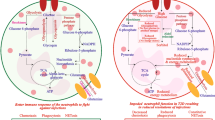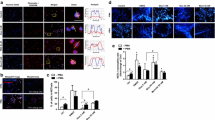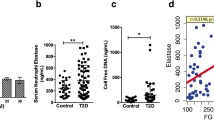Abstract
CD4+ T cell subset imbalance plays an important role in the development of diabetic complications. Neutrophils have recently been known as the regulator of CD4+ T cell differentiation. However, whether neutrophils affect CD4+ T cell population in diabetes is still elusive. In this study, we investigated the effect of neutrophils stimulated with advanced glycated end products (AGEs), the marker of diabetes, on CD4+ T cell differentiation and its underlying mechanism. Our data showed that the cultural medium of healthy adult neutrophils treated with AGEs increased expressions of both Th1 (IFN-γ) and Th17 (IL-17) phenotypes and the transcription factors of Th1 (Tbet) and Th17 (RORγt) in naive CD4+T cells and CD4+CD25+FoxP3+ (Treg) T cells in vitro. Next, we found that AGEs induced the generations of myeloperoxidase (MPO) and neutrophil elastase (NE) in neutrophils; inhibition of MPO or NE attenuated the effect of AGE-stimulated neutrophils on CD4+ T cell bias. Furthermore, receptor for AGEs (RAGE) inhibitor interrupted AGE-induced MPO and NE expressions, but MPO and NE inhibitions did not change AGE-increased RAGE gene expression. These results suggested that AGEs drive the effect of neutrophils on CD4+ T cell differentiation into pro-inflammatory program through inducing MPO and NE productions in neutrophils, which is mediated by AGE–RAGE interaction.






Similar content being viewed by others
Abbreviations
- AGEs:
-
Advanced glycated end products
- MPO:
-
Myeloperoxidase
- NE:
-
Neutrophil elastase
- RAGE:
-
Receptor for AGEs
- Treg:
-
Regulatory T cells
- NET:
-
Neutrophil extracellular traps
- ROR:
-
Retinoic orphan receptor
- IFN-γ:
-
Interferon-gamma
- BSA:
-
Bovine serum albumin
- PBS:
-
Phosphate-buffered saline
- ICS:
-
Intracellular cytokine staining
- GAPDH:
-
Glyceraldehyde-3-phosphate dehydrogenase
References
Maffi, P., and A. Secchi. 2017. The burden of diabetes: emerging data. Developments in Ophthalmology 60: 1–5.
Hu, H., H. Jiang, H. Ren, X. Hu, X. Wang, and C. Han. 2015. AGEs and chronic subclinical inflammation in diabetes: disorders of immune system. Diabetes/Metabolism Research and Reviews 31: 127–137.
Raghav, A., J. Ahmad, and K. Alam. 2017. Nonenzymatic glycosylation of human serum albumin and its effect on antibodies profile in patients with diabetes mellitus. PLoS One 12: e176970.
Soboleva, A., R. Schmidt, M. Vikhnina, T. Grishina, and A. Frolov. 2017. Maillard proteomics: opening new pages. International Journal of Molecular Sciences 18.
Goh, S.Y., and M.E. Cooper. 2008. Clinical review: the role of advanced glycation end products in progression and complications of diabetes. The Journal of Clinical Endocrinology and Metabolism 93: 1143–1152.
Monnier, V.M., D.R. Sell, Z. Dai, I. Nemet, F. Collard, and J. Zhang. 2008. The role of the amadori product in the complications of diabetes. Annals of the New York Academy of Sciences 1126: 81–88.
Lontchi-Yimagou, E., E. Sobngwi, T.E. Matsha, and A.P. Kengne. 2013. Diabetes mellitus and inflammation. Current Diabetes Reports 13: 435–444.
Rajendran, P., Y.F. Chen, Y.F. Chen, L.C. Chung, S. Tamilselvi, C.Y. Shen, C.H. Day, R.J. Chen, V.P. Viswanadha, W.W. Kuo, and C.Y. Huang. 2018. The multifaceted link between inflammation and human diseases. Journal of Cellular Physiology 233: 6458–6471.
Drew, W., D.V. Wilson, and E. Sapey. 2017. Inflammation and neutrophil immunosenescence in health and disease: targeted treatments to improve clinical outcomes in the elderly. Experimental Gerontology.
Mohan, T., L. Deng, and B.Z. Wang. 2017. CCL28 chemokine: an anchoring point bridging innate and adaptive immunity. International Immunopharmacology 51: 165–170.
Chistiakov, D.A., A.N. Orekhov, and Y.V. Bobryshev. 2016. Immune-inflammatory responses in atherosclerosis: role of an adaptive immunity mainly driven by T and B cells. Immunobiology 221: 1014–1033.
Hirahara, K., and T. Nakayama. 2016. CD4+ T-cell subsets in inflammatory diseases: beyond the Th1/Th2 paradigm. International Immunology 28: 163–171.
Rivas-Santiago, C.E., and G.G. Guerrero. 2017. IFN-alpha boosting of Mycobacterium bovis Bacillus Calmette Guerin-vaccine promoted Th1 type cellular response and protection against M. tuberculosis infection. BioMed Research International 2017: 8796760.
Hwang, S.S., S.W. Jang, and G.R. Lee. 2017. RHS6-mediated chromosomal looping and nuclear substructure binding is required for Th2 cytokine gene expression. Biochimica et Biophysica Acta 1860: 383–391.
Thomson, J.T., M.B. Brand, and P. FruFonteh. 2017. The role of IL17-A in the second hit of acute pancreatitis. South African Journal of Surgery 55: 51.
Balato, A., E. Scala, N. Balato, G. Caiazzo, R. Di Caprio, G. Monfrecola, A. Raimondo, S. Lembo, and F. Ayala. 2017. Biologics that inhibit the Th17 pathway and related cytokines to treat inflammatory disorders. Expert Opinion on Biological Therapy 17: 1363–1374.
Kitz, A., E. Singer, and D. Hafler. 2018. Regulatory T cells: from discovery to autoimmunity. Cold Spring Harbor Perspectives in Medicine.
Salehipour, Z., D. Haghmorad, M. Sankian, M. Rastin, R. Nosratabadi, D.M. Soltan, N. Tabasi, M. Khazaee, L.R. Nasiraii, and M. Mahmoudi. 2017. Bifidobacterium animalis in combination with human origin of Lactobacillus plantarum ameliorate neuroinflammation in experimental model of multiple sclerosis by altering CD4+ T cell subset balance. Biomedicine & Pharmacotherapy 95: 1535–1548.
Sun, L., J. Fu, and Y. Zhou. 2017. Metabolism controls the balance of Th17/T-regulatory cells. Frontiers in Immunology 8: 1632.
Astry, B., S.H. Venkatesha, and K.D. Moudgil. 2015. Involvement of the IL-23/IL-17 axis and the Th17/Treg balance in the pathogenesis and control of autoimmune arthritis. Cytokine 74: 54–61.
Handono, K., M.Z. Pratama, A.T. Endharti, and H. Kalim. 2015. Treatment of low doses curcumin could modulate Th17/Treg balance specifically on CD4+ T cell cultures of systemic lupus erythematosus patients. Cent Eur J Immunol 40: 461–469.
Prame, K.K., A.J. Nicholls, and C. Wong. 2018. Partners in crime: neutrophils and monocytes/macrophages in inflammation and disease. Cell and Tissue Research.
Hergott, C.B., A.M. Roche, E. Tamashiro, T.B. Clarke, A.G. Bailey, A. Laughlin, F.D. Bushman, and J.N. Weiser. 2016. Peptidoglycan from the gut microbiota governs the lifespan of circulating phagocytes at homeostasis. Blood 127: 2460–2471.
Perobelli, S.M., A.C. Mercadante, R.G. Galvani, T. Goncalves-Silva, A.P. Alves, A. Pereira-Neves, M. Benchimol, A. Nobrega, and A. Bonomo. 2016. G-CSF-induced suppressor IL-10+ neutrophils promote regulatory T cells that inhibit graft-versus-host disease in a long-lasting and specific way. Journal of Immunology 197: 3725–3734.
Al-Khafaji, A.B., S. Tohme, H.O. Yazdani, D. Miller, H. Huang, and A. Tsung. 2016. Superoxide induces neutrophil extracellular trap formation in a TLR-4 and NOX-dependent mechanism. Molecular Medicine 22: 1.
Domingo-Gonzalez, R., G.J. Martinez-Colon, A.J. Smith, C.K. Smith, M.N. Ballinger, M. Xia, S. Murray, M.J. Kaplan, G.A. Yanik, and B.B. Moore. 2016. Inhibition of neutrophil extracellular trap formation after stem cell transplant by prostaglandin E2. American Journal of Respiratory and Critical Care Medicine 193: 186–197.
Aarts, C., and T.W. Kuijpers. 2018. Neutrophils as myeloid-derived suppressor cells. European Journal of Clinical Investigation: e12989.
Kalyan, S., and D. Kabelitz. 2014. When neutrophils meet T cells: beginnings of a tumultuous relationship with underappreciated potential. European Journal of Immunology 44: 627–633.
Miyoshi, A., M. Yamada, H. Shida, D. Nakazawa, Y. Kusunoki, A. Nakamura, H. Miyoshi, U. Tomaru, T. Atsumi, and A. Ishizu. 2016. Circulating neutrophil extracellular trap levels in well-controlled type 2 diabetes and pathway involved in their formation induced by high-dose glucose. Pathobiology 83: 243–251.
Lee, R.H., and W. Bergmeier. 2017. Sugar makes neutrophils RAGE: linking diabetes-associated hyperglycemia to thrombocytosis and platelet reactivity. The Journal of Clinical Investigation 127: 2040–2043.
Lin, J., Y. Tang, Q. Kang, and A. Chen. 2012. Curcumin eliminates the inhibitory effect of advanced glycation end-products (AGEs) on gene expression of AGE receptor-1 in hepatic stellate cells in vitro. Laboratory Investigation 92: 827–841.
Lin, J., S. Haridas, S.J. Barenkamp, L.C. Lorenset, A. Lee, B.T. Schroeder, G. Peng, and J.M. Koenig. 2017. Neonatal neutrophils stimulated by group B Streptococcus induce a proinflammatory T-helper cell bias. Pediatric Research.
Lin, J., and A. Chen. 2011. Curcumin diminishes the impacts of hyperglycemia on the activation of hepatic stellate cells by suppressing membrane translocation and gene expression of glucose transporter-2. Molecular and Cellular Endocrinology 333: 160–171.
Najmeh, S., J. Cools-Lartigue, B. Giannias, J. Spicer, and L.E. Ferri. 2015. Simplified human neutrophil extracellular traps (NETs) isolation and handling. Journal of Visualized Experiments.
Abouzeid, S., and N. Sherif. 2015. Role of alteration in Treg/Th17 cells’ balance in nephropathic patients with type 2 diabetes mellitus. Electron Physician 7: 1613–1618.
Machado-Lima, A., R.T. Iborra, R.S. Pinto, C.H. Sartori, E.R. Oliveira, E.R. Nakandakare, J.T. Stefano, D. Giannella-Neto, M.L. Correa-Giannella, and M. Passarelli. 2013. Advanced glycated albumin isolated from poorly controlled type 1 diabetes mellitus patients alters macrophage gene expression impairing ABCA-1-mediated reverse cholesterol transport. Diabetes/Metabolism Research and Reviews 29: 66–76.
Shim, E., and J.P. Babu. 2015. Glycated albumin produced in diabetic hyperglycemia promotes monocyte secretion of inflammatory cytokines and bacterial adherence to epithelial cells. Journal of Periodontal Research 50: 197–204.
Vlassara, H., J. Uribarri, W. Cai, S. Goodman, R. Pyzik, J. Post, F. Grosjean, M. Woodward, and G.E. Striker. 2012. Effects of sevelamer on HbA1c, inflammation, and advanced glycation end products in diabetic kidney disease. Clinical Journal of the American Society of Nephrology 7: 934–942.
Luo, A., S.T. Leach, R. Barres, L.B. Hesson, M.C. Grimm, and D. Simar. 2017. The microbiota and epigenetic regulation of T helper 17/regulatory T cells: in search of a balanced immune system. Frontiers in Immunology 8: 417.
Zhang, C., C. Xiao, P. Wang, W. Xu, A. Zhang, Q. Li, and X. Xu. 2014. The alteration of Th1/Th2/Th17/Treg paradigm in patients with type 2 diabetes mellitus: relationship with diabetic nephropathy. Human Immunology 75: 289–296.
Kay, A.M., C.L. Simpson, and J.J. Stewart. 2016. The role of AGE/RAGE signaling in diabetes-mediated vascular calcification. J Diabetes Res 2016: 6809703.
Aratani, Y. 2018. Myeloperoxidase: its role for host defense, inflammation, and neutrophil function. Archives of Biochemistry and Biophysics 640: 47–52.
Scully, I.L., L.K. McNeil, S. Pathirana, C.L. Singer, Y. Liu, S. Mullen, D. Girgenti, A. Gurtman, M.W. Pride, K.U. Jansen, et al. 2017. Neutrophil killing of Staphylococcus aureus in diabetes, obesity and metabolic syndrome: a prospective cellular surveillance study. Diabetology and Metabolic Syndrome 9: 76.
Vetter, S.W. 2015. Glycated serum albumin and AGE receptors. Advances in Clinical Chemistry 72: 205–275.
Indurthi, V.S., E. Leclerc, and S.W. Vetter. 2012. Interaction between glycated serum albumin and AGE-receptors depends on structural changes and the glycation reagent. Archives of Biochemistry and Biophysics 528: 185–196.
DeLeon-Pennell, K.Y., Y. Tian, B. Zhang, C.A. Cates, R.P. Iyer, P. Cannon, P. Shah, P. Aiyetan, G.V. Halade, Y. Ma, et al. 2016. CD36 is a matrix metalloproteinase-9 substrate that stimulates neutrophil apoptosis and removal during cardiac remodeling. Circulation. Cardiovascular Genetics 9: 14–25.
Goncalves-de-Albuquerque, S., R. Pessoa-E-Silva, L. Trajano-Silva, T.C. de Goes, R. de Morais, C.O.C. Da, V. de Lorena, and M. de Paiva-Cavalcanti. 2017. The equivocal role of Th17 cells and neutrophils on immunopathogenesis of leishmaniasis. Frontiers in Immunology 8: 1437.
Trentini, M.M., F.M. de Oliveira, A. Kipnis, and A.P. Junqueira-Kipnis. 2016. The role of neutrophils in the induction of specific Th1 and Th17 during vaccination against tuberculosis. Frontiers in Microbiology 7: 898.
Munoz-Caro, T., M. Lendner, A. Daugschies, C. Hermosilla, and A. Taubert. 2015. NADPH oxidase, MPO, NE, ERK1/2, p38 MAPK and Ca2+ influx are essential for Cryptosporidium parvum-induced NET formation. Developmental and Comparative Immunology 52: 245–254.
Bhela, S., S.K. Varanasi, U. Jaggi, S.S. Sloan, N.K. Rajasagi, and B.T. Rouse. 2017. The plasticity and stability of regulatory T cells during viral-induced inflammatory lesions. Journal of Immunology 199: 1342–1352.
Acknowledgements
We are grateful for the participants who volunteered for this study and the physicians and nurses in the Department of Neurology for their assistances during the execution of the work.
Funding
The study was supported by Talent Initial funding YY2017-002 sponsored by Guangdong Second Provincial General Hospital, Grant 201707010436, from Guangzhou city scientific and technological research program and research program, Grant 20173024, sponsored by Chinese Traditional Medicine Bureau of Guangdong Province.
Author information
Authors and Affiliations
Corresponding authors
Ethics declarations
This study was approved by the Ethical Review Committee of Guangdong Second Provincial General Hospital. Informed consent of blood donation was given by healthy adult volunteers who had no record of food allergy or sensitization.
Conflict of Interest
The authors declare that they have no conflict of interest.
Rights and permissions
About this article
Cite this article
Lu, H., Xu, S., Liang, X. et al. Advanced Glycated End Products Alter Neutrophil Effect on Regulation of CD4+ T Cell Differentiation Through Induction of Myeloperoxidase and Neutrophil Elastase Activities. Inflammation 42, 559–571 (2019). https://doi.org/10.1007/s10753-018-0913-5
Published:
Issue Date:
DOI: https://doi.org/10.1007/s10753-018-0913-5




